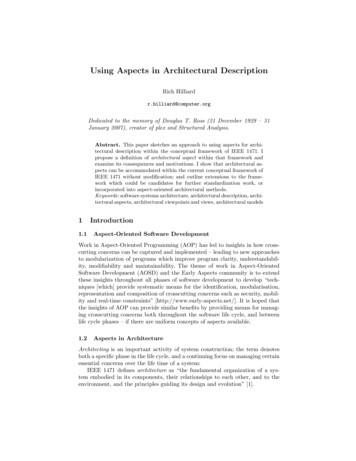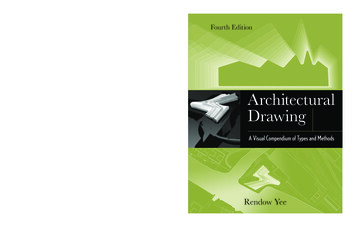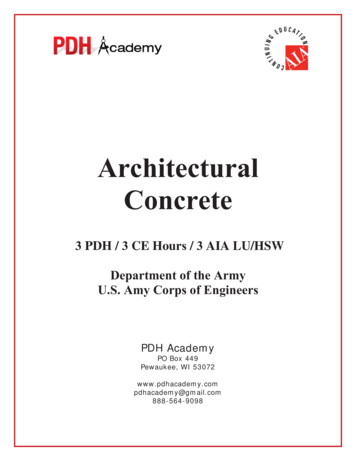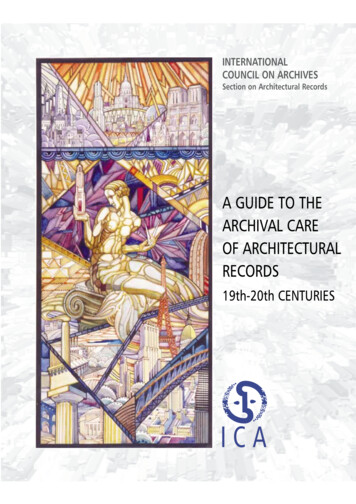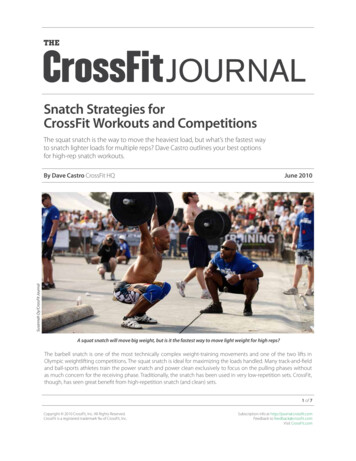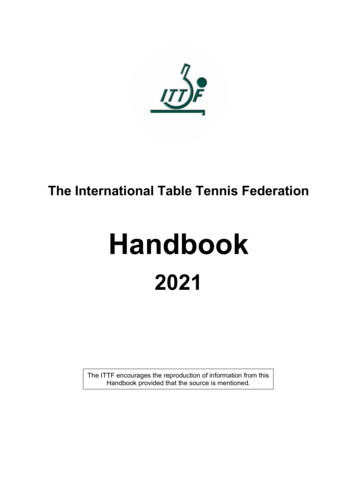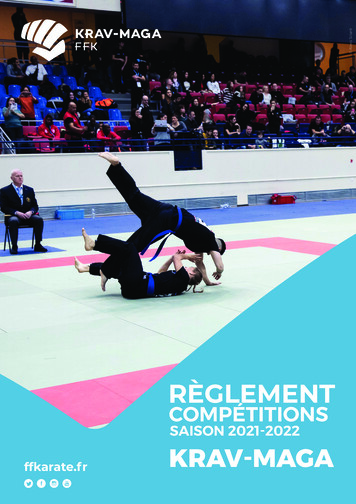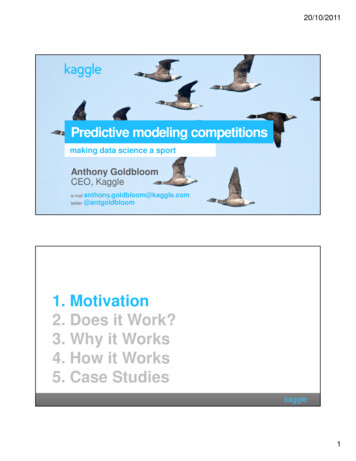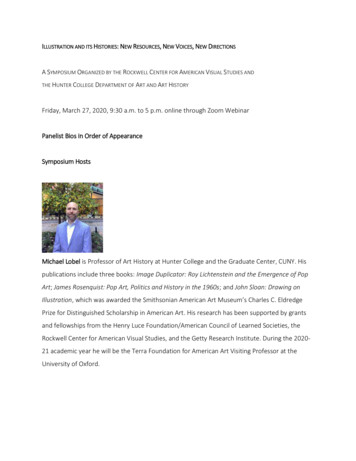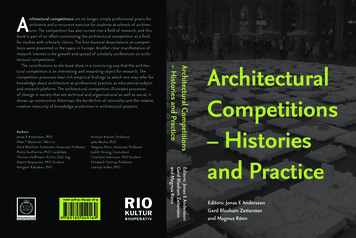
Transcription
AKristian Kreiner, ProfessorJoão Rocha, PhDMagnus Rönn, Associate ProfessorJudith Strong, ConsultantCharlotte Svensson, PhD StudentElisabeth Tostrup, ProfessorLeentje Volker, PhDisbnISBN ULTURKOOPERATIVKOOPERATIVKOOPERATIVEditors: Jonas E AnderssonGerd Bloxham Zetterstenand Magnus RönnAuthorsJonas E Andersson, PhDMats T Beckman, Tekn LicGerd Bloxham Zettersten, Associate ProfessorPedro Guilherme, PhD CandidateThomas Hoffmann-Kuhnt, Dipl. Ing.Maarit Kaipiainen, PhD StudentAntigoni Katsakou, PhDArchitectural Competitions– Histories and Practicerchitectural competitions are no longer simply professional praxis forarchitects and a recurrent exercise for students at schools of architecture. The competition has also turned into a field of research, and thisbook is part of an effort constituting the architectural competition as a fieldfor studies with scholarly claims. The first doctoral dissertations on competitions were presented in the 1990s in Europe. Another clear manifestation ofresearch interest is the growth and spread of scholarly conferences on architectural competitions.The contributions to the book show in a convincing way that the architectural competition is an interesting and rewarding object for research. Thecompetition processes bear rich empirical findings to which one may refer forknowledge about architecture as professional practice, as educational subjectand research platform. The architectural competition illustrates processesof change in society that are technical and organizational as well as social; itshows up constructive dilemmas, the borderline of rationality and the relative,creative insecurity of knowledge production in architectural projects.ArchitecturalCompetitions– Historiesand PracticeEditors: Jonas E AnderssonGerd Bloxham Zetterstenand Magnus Rönn
Architectural Competitions– Histories and Practice
ArchitecturalCompetitions– Historiesand PracticeEditors: Jonas E AnderssonGerd Bloxham Zetterstenand Magnus RönnThe Royal Institute of Technologyand Rio Kulturkooperativ
Buying the book?Contact: al competitions – histories and practicePublishers: The Royal Institute of Technology and Rio KulturkooperativHomepage: http://www.riokultur.se/Editors: Jonas E Andersson, Gerd Bloxham Zettersten and Magnus RönnAuthors: Maarit Kaipiainen, Antigoni Katsakou, Jonas E Andersson, Magnus Rönn, Judith Strong,Pedro Guilherme, João Rocha, Leentje Volker, Kristian Kreiner, Charlotte Svensson, ElisabethTostrup, Thomas Hoffmann-Kuhnt and Mats T BeckmanCover image by Antigoni Katsakou from the exhibition Concours Bien CulturelFinancial support: Estrid Ericsons Stiftelse, Stiftelsen Helgo Zettervalls fond, Stiftelsen J. Gust. RichertStiftelsen, Lars Hiertas minne and Danish Building Research Institute, SBi at Aalborg UniversityISBN: 978-91-85249-16-9Graphic design: Optimal PressPrinting: Nordbloms tryck, Hamburgsund, Sweden 2013
ContentsEditors’ comments7jonas e andersson, gerd bloxham zettersten and magnus rönnChapter 1:Architectural Competitions in Finlandmaarit kaipiainen23Chapter 2: 37The competition generation.Young professionals emerging in the architectural scene of Switzerland throughthe process framework of housing competitions – a case studyantigoni katsakouChapter 3: 67Architecture for the “silvering” generation in Sweden– Architecture competitions as innovators for the elderlyjonas e anderssonChapter 4:107Experience of prequalification in Swedish competitions for new housing for theelderlymagnus rönnChapter 5:Prequalification in the UK and design team selection proceduresjudith strong135Chapter 6: 159Architectural competitions as lab– a study on Souto de Moura’s competition entriespedro guilherme and joão rocha
Chapter 7: 193Facing the challenges of organising a competition– the Building for Bouwkunde caseleentje volkerChapter 8: 217Constructing the Client in Architectural Competitions.An Ethnographic Study of Architects’ Practices and the Strategies They Revealkristian kreinerChapter 9:Inside the jury room.Strategies of quality assessment in Swedish architectural competitionscharlotte svensson245Chapter 10: 263High ideals on a tricky site.The 1939 Competition for the New Government Building in Osloelisabeth tostrupChapter 11: 291The balancing act between historicism and monument preservationin some international competitions in Germanythomas hoffmann-kuhntChapter 12: 319The architecture competition for the Stockholm – Bromma Airport, 1934mats t beckman
andersson, bloxham zettersten & rönn: editors’ commentsEditors’ Commentsjonas e anderssongerd bloxham zetterstenand magnus rönnTo be in the position of presenting accounts that are exciting as well as instructive and informative on the subject of architectural competitions is a pleasure.Something has happened. Competitions are no longer simply professionalpraxis for architects and a recurrent exercise for students at schools of architecture. The competition has also turned into a field of research, and this book ispart of an effort constituting the architectural competition as a field for studies with scholarly claims. The competition as a field of research reflects a newphase of development with an inception in an academic interest and in a needfor research. It is surprising that research into architectural competitions hasbeen so limited until now, in particular when considering the fact that the modern architectural competition is an institution in function in Europe for morethan 150 years, having played a central role, both for practicing architects and inarchitectural education. The introduction of competition rules during the late19th century and at the beginning of the 20th coincides with architects gettingprofessionally organized in associations and unions.The first doctoral dissertations on architectural competitions were apparently presented in the 1990s at institutions for architecture in Sweden andNorway. Now there are around fifteen academic dissertations and a number ofongoing doctoral projects in Canada and Europe. Another clear manifestationof research interest is the growth and spread of scholarly conferences on architectural competitions. Until now four conferences have been carried out with astart in Stockholm in 2008, followed by Copenhagen in 2010, and Montreal andHelsinki in 2012. A fifth scholarly conference focusing on architectural competitions will be taking place in Delft in 2014.The driving force behind research interest may be found in the deregulation and market orientation of the building constructions sector during thearchitectural competitions – histories and practice7
andersson, bloxham zettersten & rönn: editors’ comments1980s and the reregulation in the 1990s through the European Parliament andCouncil directive (2004/18/EC), regulations that have been transferred into thenational legislation of the member countries. The architectural competition isseen as a way of benefitting competitive engagement. Through revisions of thelegislation after 1994, the competition has acquired a double role, becomingboth (a) a method for producing good solutions to design problems in architecture and urban design, and (b) a formal instrument for the procurement ofservices for public architecture commissions. The news here is not that prizes incompetitions lead to commissions, but the fact of the directive which is a jointone for the member countries in Europe. According to Swedish application ofthe EU directive the demand for a competition is met if at least three firms orteams participate. The inner market may also be limited by national languagerequirements in public tendering.A controversial regulation in directive 2004/18/EC is the demand for anonymity in article 74, stating that the jury must not know the identity of the authors of the competition entries. The good intentions behind this demand areevident. It is the professional qualities of the competition proposals that engender the decision—nothing else. The commission must go to the authors ofthe best overall solution to the design problem. A competent jury, detached inrelation to the competing architects, must find the winner on the basis of themerits of the proposals. The jury members must not allow themselves to beaffected by the reputation, education, experience or financial status of the competitors. But the demand for anonymity has a down side. The organizers beginto look around for alternative ways of public procuring. The rise of dialoguecompetitions in Denmark is a way of bypassing anonymity. Another outcome isthe development of forms of procedure, similar to competitions but outside ofcompetition rules and the control of the architects’ organizations.Supported by legislation, organizers can now make far-reaching demands onthe architectural practices in their invitations to prequalification in competitionswith a limited number of participants, but the will to compete within architecture and urban design cannot be forced. That urge is not to be found in regulations or administrative directives, but in the engagement of architects and socialplanners. The spirit of competing has a background in the Jesuit schools, knownfor their efficient and competitive education. Sancta Æmulatio, the holy urge tocompete, was encouraged by giving each pupil an æmulus with whom he shouldcompare himself and who had as his task to stimulate learning (Liedman, 2007).8architectural competitions – histories and practice
andersson, bloxham zettersten & rönn: editors’ commentsThrough continual comparisons the students were to be spurred on to improvetheir performance, which was training in being both colleagues and rivals.We know more about the role of the competition in the French educationof architects in the 18th century, a form of learning that was refined in theacademies and copied around Europe and the US. The essential element ofteaching at the Académie d’architecture and the École des Beaux Arts was theannual Grand Prix competition (Bergdoll, 1989; Svedberg, 1994; Wærn, 1996).The students were to make an independent first sketch which was then developed in studios under the supervision of a master into detailed drawing onwall charts. The pedagogical point is clear. Through the sketch the individualabilities of the students were tested to quickly analyse the competition problem at hand, devising a fundamental idea as a basis for design. The designproposal was to show if the task had been solved in a qualified way, and thiswas crucial for the move up into the next form. The charette method, initiatedat the Paris academies of the 19th century, is a modern variant of the workmethod at the École des Beaux Art, denoting the practice of solving complexdesign problems in intensive sittings. The competitions gave the academiesa status as an international meeting place in the 18th century. Socializationinto competition culture was started, as we have seen, already during the architects’ education when the competition became a central exercise in thelearning process.Traces of the French tradition of competitions survive in present-day architectural education in the recurrent student exhibitions of exam projects. Theneed to compare the design projects, evaluating their quality, has also laid thebasis for architectural critique as a method for the evaluation and grading ofproposals. In the French tradition jury members were invited to examine andcomment on the students’ solutions of a yearly completion task.Participating in architectural competitions is associated both with a playfullearning process, delight, collaboration and with competition in dead earnest.The tension of the chase for the fundamental idea that will resolve the designproject has been testified to among practicing architects. The time for the handing in of the proposals is approaching irrevocably. When the competition proposals have been sent in and exhibited, the members of the jury walk around inthe room to acquaint themselves with the design solutions. A sense of curiosityand delight fills the exhibition room. A new world is being opened before theeyes of the jury. The future is at stake.architectural competitions – histories and practice9
andersson, bloxham zettersten & rönn: editors’ commentsPart of competition culture is making the proposals public through exhibitions, where they become the object of critical review in a form of worthyemulation of each other. Competition programs, competition proposals andjury statements are possible to download from home pages. The public presentation of architectural projects in competitions via home pages, journals andexhibitions lend communal character to knowledge production. Education andprofessional praxis combine in the creation of a professional identity wherecompetitions play a key role with their own rules, secretaries and competitionboards to supervise the conditions of competitions. It is this professional control that is being challenged by new competition forms and administrative directives in public procurement acts.The architectural competition is a future oriented production of knowledgethrough architectural projects. From that perspective the competition takes onan appearance of futuristic archeology. The future is being investigated withthe support of design—not how it is, but how it could be if the proposals wereto be implemented. What is important here is that the proposals contain different modes of solution for the same competition design problem. There isno given answer, no “correct solution”, but instead the potential of alternativegood solutions to the competition task at hand. For this reason doubt and lackof certainty is a constant companion in the jury’s examination of the designproposals.That architectural competitions generate knowledge is hardly a controversialstatement. Nor is the assumption that the learning process implies the handlingof drawings and illustrations as though they constitute built environment. It iswhen we take up the question of the nature of knowledge, how knowledge maybe given form and communicated that the question becomes controversial. It ischaracteristic of architectural projects that knowledge is embedded in the image and is communicated via drawings, illustrations and diagrams. The aim isfor the images to be self-explanatory. Sometimes brief explanations in text areneeded. However, the descriptive text has no value in itself, but is intended onlyto clarify the knowledge that is already deposited in the images and being conveyed through visual impressions. It is an already formed environment which isbeing revealed to the observer as design. The pictures transmit experience. Thetext on the other hand is intellectual in character, appealing to reason. Consequently, text and image represent two very different understandings of knowledge which are both to be found in architectural competitions, and which are10architectural competitions – histories and practice
andersson, bloxham zettersten & rönn: editors’ commentsmade manifest in the mode of communication and visualization of knowledgeto the observer.Architectural competitions are based on three fundamental presuppositions:(a) that drawings and visualizations may transmit credible knowledge and (b)that quality in architecture is something that may be seen and transmitted viaimages. And in a principal view, (c) that architectural projects is a practicablemethod for investigating the future and testing ideas. Through visualizationsthe observer gets a fast and clarifying, efficient and easy to grasp overall picture of the architectural projects. Learning lies in the meeting with the image.The idea of efficient evaluation, too, is included in the competitions tradition. Agroup of competent practitioners is assumed to be able to read the imagery ofarchitecture, understand the architectural projects and point to qualities, omissions and non-clarities in the proposals. That is how the basis for jury procedure looks.Faith in the architectural competition as a professional tool for the production of knowledge assumes that organizers may trust the judgments made bycompetent members of a jury, in spite of the fact that the proposals representonly a certain number of possible visions of the future. It is not examples of“real” environment but visualized proposals that are being tested. However,computer graphics make it possible for the illustrations of an architectural project to have photographic precision, looking like pictures of real built environment. We are easily fooled by the degree of detail. Therefore good judgmentis central in the evaluation of proposals in competitions and their simplifiedinterpretations of the future. Good judgment is the product of experience, examples, praxis and training. We cannot read up on good judgment; instead arich repertoire of cases is required that may be reused as experience, principlesand patterns for the development of solutions in new situations.Thus there is a movement in competition processes that makes the transmission of knowledge shift between text and image. The centre of gravity varies.The introductory invitation to architectural practices is a brief text descriptionof the competition’s design task and its conditions. The competition programs,too, convey information as text on the task at hand with a supplementary material of maps and pictures of the site. The competition proposals on the otherhand employ the image as their principal source of knowledge. So there is aclear displacement of the centre of gravity. The proposals for solutions to thedesign problems are visualized in drawings, illustrations and models. At thisarchitectural competitions – histories and practice11
andersson, bloxham zettersten & rönn: editors’ commentsstage the image is the central element in the transmission of knowledge. Without images, no design. After that the text takes over. The jury statement is awritten report accounting for the outcome of the evaluation. Visualizations ofawarded proposals are included, but only for the purpose of illustrating theconclusions of the jury. The text is the medium for transmission of information. It is by reading the jury statement that we learn which of the architecturalprojects in the competition that has been awarded 1st prize.As matters stand, in text-based communication images are used to illustratethe knowledge that is deposited in written language. The text is king, powerlies in the word. Architectural projects represent a diametrically opposed conception of knowledge. Now it is the image that transmits knowledge about thefuture. Knowledge is being visualized. The eye is given the deciding function.Seeing the quality in an architectural project has priority to the descriptive text.In order to be successful in architectural competitions the competing architects must catch the attention of the jury, and that is not done through writtenlanguage, but by design. In the meeting with the proposals the jury sees thearchitectural projects as a built environment with qualities, non-clarities andomissions. In a mental process, the jury members enter the imagery, trying toexperience the drawings as real-life environment.A common denominator for most article contributions in this book is thatthey describe an epistemological axis activated through the competition process. The epistemological axis in competitions encompasses both text and imagery as empirical findings. This combined knowledge, which the texts and theimages supply, makes it possible to define a typology, in which the architecturalprojects of the competitions describe principal solutions to specific designproblems. Through this analysis, we may point to patterns, lines of development and breaks in trends.Therefore we open the book by bringing out competitions as viewed froma national horizon. The first contribution by Maarit Kaipiainen is a survey ofarchitectural competitions in Finland. Since the 1870s about 2000 competitionshave been organized in Finland. Kaipiainen’s contribution is based on a catalogue that was compiled for the exhibition on architectural competitions shownat the Museum of Finnish Architecture in Helsinki in 2008. Here we have anoverall description of the competitions system. An interesting difference fromother European countries is the fact that the competition rules contain a specific paragraph laying down the handing over of the competition material to the12architectural competitions – histories and practice
andersson, bloxham zettersten & rönn: editors’ commentsmuseum of architecture. The wording goes: “In a design competition, the conditions and the judges’ report, including attachments, but with the exceptionof classified portions, shall be filed in a reliable way. In the case of architecturalcompetitions the competition material shall be filed by the Museum of Finnish Architecture” (SAFA Competition Rules, 2008). Since the rules are the sameones for architects and their clients, this paragraph may be interpreted as a signthat the competition results are viewed as a collective source of knowledge thatneeds to be documented and made available to research.The second article is an investigation of the contemporary competitions culture in Switzerland. Antigoni Katsakou gives us a tale of success. Every year c.200 competitions are carried through in Switzerland. From the point of view ofarchitecture this country is inspiring and instructive. Through Antigoni Katsakou’s contribution we get an insight into a specific competitions system making it possible for young architects to win competitions, start up architecturalpractices and begin to build their professional careers. Switzerland has a longtradition of competitions and an advanced competitions system that evidentlyencourages professional renewal. But here, too, external forces challenge thetradition. One threat is the changeover from open competitions to invited ones,making it hard for young architects to succeed in the competitive battle againstestablished architectural offices with good references and a sound reputation.The competition as a tool for tendering makes for an administrative and legaldisplacement of the centre of gravity. Katsakou also points to the new modes ofrepresentation, computer-based images, as an internal challenge. The contestants produce visualizations that are increasingly true to life in their architectural projects of future examples of environment, which makes clients believethat the conceptual proposals are ready to be built. The competition projectsare rendered as elaborated ones before the jury has chosen the winner and theorganizer has given the 1st prize winner the design commission. The new waysof visualizing architectural projects have a photographic precision that affectsboth the image and the understanding of its contents.The third contribution to the book gives an account of the way in which thearchitectural competition in Sweden has been used as a sociopolitical instrument in the development of appropriate dwellings for an aging population, achallenge that Sweden shares with many welfare states. Jonas E Andersson describes a national drive in Sweden in 2011-2012 that focused on housing for theelderly and that used the architecture competition as a professional laboratoryarchitectural competitions – histories and practice13
andersson, bloxham zettersten & rönn: editors’ commentsin order to generate innovative solutions and creative proposals for the task.Supported by a governmental program, three invited competitions were carriedout in the municipalities of Burlöv, Gävle and Linköping. Andersson gives asurvey of the competition processes and an analysis of the winning architectural projects. The architectural competitions illustrate two ways of meeting theneeds of the aging society. One way presupposes the inclusion of apartmentsfor the elderly in common residential building. This housing type is intendedfor continued living in a familiar environment, i.e. aging in place. The other wayis to design special housing for frail elderly people who are in need of care andcaring around the clock, i.e. the assisted living concept. However, the secondtype of housing is not freely available on the market; but instead, access dependsupon an assessment made by the municipal administration for eldercare of theolder person’s need of assistance and care, motivated by a diagnosis or a medicalcondition. This type of housing combines the deeper meaning of home withthe demands on an appropriate work environment for the care staff. Whicheverthe orientation, the conclusion of the three competitions is that appropriatehousing for the aging society should be provided with universal architecturalqualities and general accessibility and usability, in line with the concept “Designfor all” or “Universal Design”. The fundamentally different types of architectonic solution may at best be combined, integrated in common residential areas.The fourth and fifth contributions deal with prequalification, which is a selective procedure in competitions with a limited number of participants. Theprequalified competition is now a dominant form. Its spread may be viewedas a result of the organizers’ wish for control, administrative rules and the demand for a cheaper, faster and more efficient process, from invitation to program work and the contract offered to the 1st prize winner. The rationale of suchdemands may, on good grounds, be questioned in the light of the long life ofbuildings.Magnus Rönn opens the discussion on the basis of experience of a selectionof architectural practices for three competitions for dwellings for the elderlythat were carried through in 2011-2012. A total of 120 design teams sent in theirapplications in expectation. Eleven teams were invited. Obviously the battlefor places in the competition was very hard. Only 9% could proceed. That isa standard figure, for Sweden. Through their invitation to prequalification theorganizers had access to a large number of applications from competent architectural offices with good references and a good reputation within the sector.14architectural competitions – histories and practice
andersson, bloxham zettersten & rönn: editors’ commentsThat is one reason for the seclusion of young architects and newly establishedpractices. Magnus Rönn makes a critical investigation of the prequalificationprocess through interviews and an analysis of documents in the archives. In order to be invited the candidates had to satisfy a number of “must have” demandsreferring to prescriptions in the Swedish Public Procurement Act, LOU. It is aprerequisite for being allowed to proceed in the evaluation. The professionalmerits of the candidates are then tested on the basis of criteria for design ability,creativity, competence and resources. It is in this evaluation that the organizerappoints the design teams selected to participate in developing solutions to thecompetition design task.Judith Strong carries on the discussion by investigating selection proceduresin England and their influence on the competitions tradition. She describesattempts to develop alternative procedures as a way of softening the negativeeffects of the prequalified competition, as well as the difficulty experienced bysmaller architectural practices in getting invited, the bureaucratization throughlegislation and the demand for anonymity which makes the organizer hesitant regarding competitions as a form. According to Strong the open competition has vanished, in principle, in England. But this is not just an effect ofthe demands for anonymity. A strongly contributing factor is privatization. Nolonger is there a public sector organizing open architectural competitions fornew housing, hospitals, schools and buildings for municipal activities. The newmethods of selection began to be developed in England in the 1990s. In herarticle Strong examines the different ways of selecting architects for commissions. Here there are dialogue-based methods that start out from simple interviews and presentations at meetings, to go on to scrutiny that may be likenedto examination, short-listing of candidates based on references and analyses ofcompetition programs for complex design tasks. Increasingly often the competition problems call for multidisciplinary design teams.From the competition as an instrument for selection and procurement weturn our eyes to a Portuguese architect who has gained international reputation.Pedro Guilherme and João Rocha present in their contribution Souto de Mouraand a selection of his competition projects. Souto de Moura is an architect withstar status operating on the international stage. During the period 1979-2010Souto de Moura participated in fifty national and international architecturalcompetitions. In fourteen of these competitions he was awarded 1st prize, andin particular in the national competitions organized in Portugal. Guilhermearchitectural competitions – histories and practice15
andersson, bloxham zettersten & rönn: editors’ commentsand Rocha describe and analyse some fundamental traits in Souto de Moura’sdesign ideas in four competition projects used as case studies. We may watchhow design evolves in the architectural projects via sketches, models and images used for reference. In the centre of the case studies there is an attempt atidentifying an architectural grammar in Souto de Moura’s work. The cases areanalysed in terms of authenticity and reuse, readability, simplicity and clarity, aswell as materiality and time. The competition proposals are used in the articleas sources for understanding of his idiom.What could be a better competition design task than a school of architecture? Leentje Volker gives us an account of the competition for a new architecture school at Delft University. The backgr
The contributions to the book show in a convincing way that the architec-tural competition is an interesting and rewarding object for research. The competition processes bear rich empirical findings to which one may refer for knowledge about architecture as professional practice, as educational subject and research platform.
